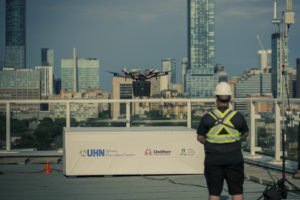
The use of drones for organ transport could revolutionize the field and save lives. Bromont Unither transports lungs in Toronto, Canada, to demonstrate how it works.
by DRONELIFE Staff Writer Ian M. Crosby
Last month, Bromont Unither Bioelectronics, a United Therapeutics subsidiary, succeeded in transporting lungs via drone between two Toronto hospitals, “a springboard” that could revolutionize the field of transplants, according to Unither’s vice-president Mikaël Cardinal.
The drone travelled over a distance of 1.5 km, delivering its 6 kg payload from Toronto Western Hospital to Toronto General Hospital, where a patient successfully received his transplant at the end of September.
“This is truly a remarkable achievement in terms of complexity, in controlled airspace and flight over high population density,” said Cardinal, who coordinated the design, development and flight of the drone.
Though fully automated, the drone was closely monitored by a pilot in the event of a glitch.
Toronto General Hospital was selected for the demonstration due to its history as the first hospital to perform a successful lung transplant in 1983.
Though Cardinal concedes that the 1.5 km transport could have been accomplished through more typical methods, he believes that drone transport has the potential to save lives even when employed over short distances, in the event of traffic congestion, for example.
Bromont is currently developing three aircraft which will have a range of between 35 and 463 km, allowing for transport to regions far from major centers.
“The main challenge is to demonstrate the consistency and safety of operations by integrating different technologies,” explained Cardinal. “For example, a transport system has been developed, a box which adapts to the drone which is very easily deployable, which maintains the thermal parameters of the organ, which protects it from its environment and from vibrations.”
This is not the first time that a drone has been used for transporting organs; That took place in April 2019 with the transport of a kidney to the University of Maryland Medical Center in Baltimore. Additionally, September 2020 saw the delivery of corneas and kidneys to Nevada and a pancreas to Minnesota. “In the case of a lung, this is a world first,” said the vice-president.
“In the case of Unither Bioelectronics, like its predecessors, it is currently a matter of prototypes and demonstrations. It is not until 2025 that we hope to bring such a commercial solution to the market. This would cost ‘40 to 60% less’ than transport by helicopter, because it requires less maintenance and mobilizes less staff,” Cardinal said. “We have demonstrated with our larger drones, thanks to the great simplicity of the systems, that we will be able to deliver organs directly to hospital sites with lower maintenance and operating costs.”
Cardinal also noted that the company intends to pursue the development of artificial organs, the use of “xenopoumons” from other animal species and the 3D printing of organs.
As of December 31, 2020, 802 people in Quebec were waiting for an organ transplant, which 390 received during the year, according to Transplant Quebec; 43 people died while waiting for their transplant.
Read more about drones for organ transport, drones for medical delivery, drone delivery on hospital campuses, and drones carrying AED technologies.
 Ian attended Dominican University of California, where he received a BA in English in 2019. With a lifelong passion for writing and storytelling and a keen interest in technology, he is now contributing to DroneLife as a staff writer
Ian attended Dominican University of California, where he received a BA in English in 2019. With a lifelong passion for writing and storytelling and a keen interest in technology, he is now contributing to DroneLife as a staff writer

Miriam McNabb is the Editor-in-Chief of DRONELIFE and CEO of JobForDrones, a professional drone services marketplace, and a fascinated observer of the emerging drone industry and the regulatory environment for drones. Miriam has penned over 3,000 articles focused on the commercial drone space and is an international speaker and recognized figure in the industry. Miriam has a degree from the University of Chicago and over 20 years of experience in high tech sales and marketing for new technologies.
For drone industry consulting or writing, Email Miriam.
TWITTER:@spaldingbarker
Subscribe to DroneLife here.







[…] post Drones for Organ Transport: Revolutionizing the Field of Transplants appeared first on […]